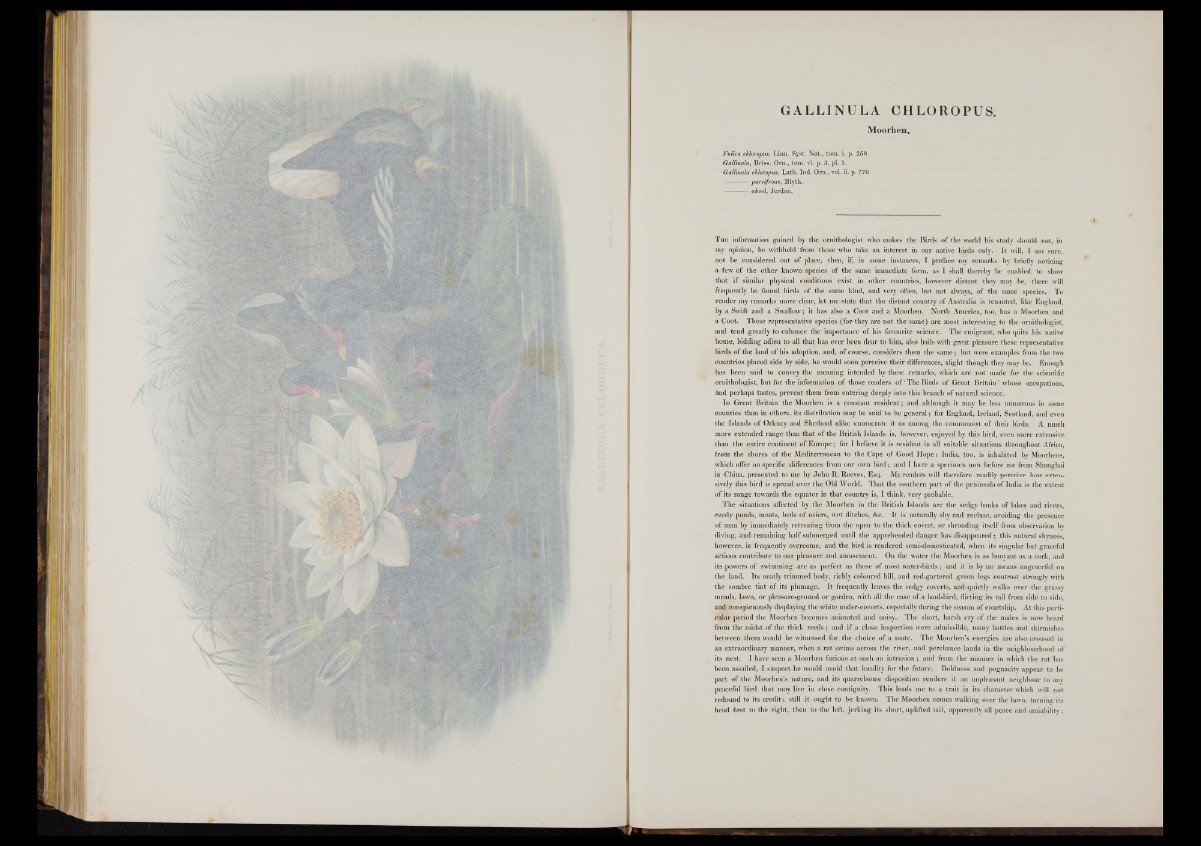
GALLINULA CHLOROPUS.
Moorhen.
Fúlica chloropus, Linn. Syst. Nat., tom, i. p. 258.
Gallínula, Briss. Ora., tom. vi. p. 3, pl. 1.
Gallínula chloropus, Lath. Ind. Ora., vol. ii. p. 770.
-----------parvifrons, Blyth.
-----------akool, Jerdon.
T he information gained by the ornithologist who makes the Birds of the world his study should not, in
my opinion, be withheld from those who take an interest in our native birds only. It will, I am sure,
not be considered out of place, then, if, in some instances, I preface my remarks by briefly noticing
a few o f the other known species of the same immediate form, as I shall thereby be enabled to show
that if similar physical conditions exist in other countries, however distant they may be, there will
frequently be found birds of the same kind, and very often, but not always, o f the same species. To
render my remarks more clear, let me state that the distant country of Australia is tenanted, like England,
by a Swift and a Swallow; it has also a Coot and a Moorhen. North America, too, has a Moorhen and
a Coot. These representative species (for they are not the same) are most interesting to the ornithologist,
and tend greatly to enhance the importance of his favourite science. The emigrant, who quits his native
home, bidding adieu to all that has ever been dear to him, also hails with great pleasure these representative
birds o f the land o f his adoption, and, of course, considers them the same; but were examples from the two
countries placed side by side, he would soon perceive their differences, slight though they may be. Enough
has been said to convey the meaning intended by these remarks, which are not made for the scientific
ornithologist, but for the information of those readers of ‘ The B irds of Great Britain ’ whose occupations,
and perhaps tastes, prevent them from entering deeply into this branch o f natural science.
In Great Britain the Moorhen is a constant resident; and although it may be less numerous in some
counties than in others, its distribution may be said to be general; for England, Ireland, Scotland, and even
the Islands of Orkney and Shetland alike enumerate it as among the commonest of their birds. A much
more extended range than that o f the British Islands is, however, enjoyed by this bird, even more extensive
than the entire continent :of Eu ro p e ; for I believe it is resident in all suitable situations throughout Africa,
from the shores of the Mediterranean to the Cape o f Good H o p e ; India, too, is inhabited by Moorhens,
which offer no specific differences from our own b ird ; and I have a specimen now before me from Shanghai
in China, presented to me by John R. Reeves, Esq. My readers will therefore readily perceive how extensively
this bird is spread over the Old World. That the southern p art of the peninsula of India is the extent
of its range towards the equator in that country is, I think, very probable.
The situations affected by the Moorhen in the British Islands are the sedgy banks of lakes and rivers,
reedy ponds, moats, beds of osiers, wet ditches, &c. It is naturally shy and recluse, avoiding the presence
o f man by immediately retreating from the open to the thick covert, or shrouding itself from observation by
diving, and remaining half submerged until the apprehended danger has disappeared; this natural shyness,
however, is frequently overcome, and the bird is rendered semi-doinesticated, when its singular but graceful
actions contribute to our pleasure and amusement. On the water the Moorhen is as buoyant as a cork, and
its powers of swimming are as perfect as those of most water-birds; and it is by no means ungraceful on
the land. Its neatly trimmed body, richly coloured bill, and red-gartered green legs contrast strongly with
the sombre tint o f its plumage. It frequently leaves the sedgy coverts, and quietly walks over the grassy
meads, lawn, or pleasure-ground o r garden, with all the ease o f a land-bird, flirting its tail from side to side,
and conspicuously displaying the white under-coverts, especially during the season of courtship. At this particular
period the Moorhen becomes animated and noisy. The short, harsh cry of the males is now heard
from the midst o f the thick re e d s ; and if a close inspection were admissible, many battles and skirmishes
between them would be witnessed for the choice o f a mate. The Moorhen’s energies are also aroused in
an extraordinary manner, when a rat swims across the river, and perchance lands in the neighbourhood of
its nest. I have seen a Moorhen furious a t such an intrusion; and from the manner in which the rat has
been assailed, I suspect he would avoid that locality for the future. Boldness and pugnacity appear to be
p art of the Moorhen’s nature, and its quarrelsome disposition renders it an unpleasant neighbour to any
peaceful bird that may live in close contiguity. This leads me to a trait in its character which will not
redound to its c red it; still it ought to be known. The Moorhen comes walking over the lawn, turning its
head first to the right, then to the left, jerking its short, uplifted tail, apparently all peace and amiability;